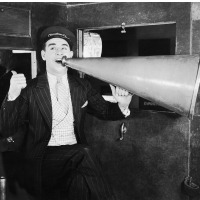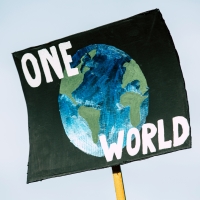Photo by Rodion Kutsaiev on Unsplash
William Makower is a regular commentator and speaker both in the UK and abroad to government and national institutions on how to benefit from continuous digital change. He shares with us his predictions for the future of digital fundraising in a post-Covid world.
The so called “Freedom Day” is now several weeks behind us, and whilst the Delta variant continues to surge, the Government’s hopes that hospitalisations will not increase have largely been borne out. As we begin to tentatively venture back into the offices, what are the short- and longer-term implications of this exit into a post-Covid world for fundraisers?
How has the landscape changed and, of personal interest to me, what longer term changes to digital fundraising can we expect? Here then are my five predictions for the evolution and role of digital fundraising in the charity sector: two short term, three longer term.
Short-term predictions
Prediction 1 - Non-touch giving will surge
By non-touch I’m referring to all forms of non-cash i.e., text as well as contactless, QR codes (more later) and web. These means of giving will continue to grow exponentially and fundraisers need to learn how to use them, what the giving-psychology is behind each one and when they are most powerful.
Future non-touch giving will include voice-activated giving e.g., “Alexa, set-up a direct debit of £5 to WaterAid” and again, progressive fundraisers need to be trailing such options.
Make no mistake, non-touch is not only growing due to Covid, but Covid has taught us that non-cash is better for three reasons:
- Easier - even if donors carry cash (and increasingly they carry less) cash is dirty, fiddly and requires visits to a cash point
- Data - cash carries no data-labels in contrast to digital which, at a minimum, gives us such data points as date/time/type
- Value - now, and increasingly, Government is simplifying Gift Aid collection. Filling in wet paper forms with pens that don’t work is an aggravation. Utilising a perpetual digital Gift Aid registration form is revolutionary.
Prediction 2 - QR code giving will become mainstream
QR codes were invented 25 years ago in Japan but, even though the source code was made open by Toyota, uptake and usage has stuttered…until, in the UK, Track and Trace made QR codes ubiquitous.
Now, using a QR code on a smartphone is as understood and accessible as taking a selfie. For fundraisers they have immediate benefits - they announce that your charity is digitally savvy and up to date. Providing the immediate framing of needing your mobile phone, they also provide handy direct links to web information pages or donation pages, and, finally, they are reassuringly secure in that they don’t, of themselves, transact funds.
Primarily though, they remove the need for a donor to stop and give their time tapping a complicated web address (with all the associated typo frustrations) into a smartphone.
Smart fundraisers will move to offering QR codes for all sorts of things from atomised fundraising options through to deeper discovery of the charity’s work. We will see a proliferation of QR code usage and that will be to the benefit of all.
Case Study
Upper Norwood Library Trust uses QR codes in various ways including printed media and live streaming channels. During the Crystal Palace Christmas event, the Trust’s live stream displayed the DONATE™ QR code and totaliser screen as part of a digital overlay. Donations made through the QR code during the event were 45% larger than those that were donated by the online webpage.
Longer-term predictions
Prediction 3 - Hybrid events will fall away, online-only events will grow
Online-only events grew in popularity during the lockdown periods. In part, this was from necessity but equally, charities learnt that they provided greater reach, engaged in different ways and were quicker and cheaper to deliver than offline events.
Innovation here is key; online quizzes flooded the market during 2020 and have run their course, so instead consider more varied formats of interactive events such as magic shows, opera, murder mystery, request shows and much more.
Fundraising for these online events may be based around ticketed sales or donations but again, think about adding additional revenue via sponsorship, in-play advertising, partnering and much more. As an example, we saw massive growth in text-raffles. Simple to set-up, quick to launch and providing donors with the ‘flutter’ experience of lotteries, text raffles proved successful for schools, local charities, and churches where £3000 can make a significant difference.
Case Study
Tête À Tête, an innovator in hybrid events, have been running their festivals and shows as hybrid experiences since 2008. Filming live and digital works to deliver funding directly to the artists, Tête À Tête strives to bring a live experience into all works using techniques such as live panel discussions or audience inputting into storylines.
Audiences have grown internationally, and the charity now has a viewership of 1m+.
Artists ask for donations during the show with experience shows that the lower priced ticketholders often donate most generously. Artistic Director Bill Bankes-Jones https://www.tete-a-tete.org.uk/lessons-from-2020-the-movie/
Prediction 4 - Match giving will be easier and more powerful
Charities know that match giving is hugely powerful. The annual “Big Give” campaign supported by the Reed Foundation raises millions of pounds for charities. To this point, match giving has been hard to manage with large companies relying on CSR departments managing the process and smaller companies using unwieldy and cumbersome spreadsheets or shying away from the administrational challenges.
Digital provision will drive change in this area supporting improved access to corporate support and functionality to vastly improve the management, reporting and collection of matched funds. Charities will benefit from greater certainty of funding, corporates will be given increased exposure and critically, donors will know their funds are working twice as hard.
Prediction 5- Data science will become mainstream
Data science covers data analysis, algorithmic computation, machine learning, pattern matching and much more.
Previously much of this has been the preserve of large corporations and Government but increasing ubiquity, simplified interfaces and growing demand will drive costs down and make these capabilities available to all. To get an idea of what is available look at Rapid Miner or DataBricks amongst others.
Charities investing in data science will better understand their donors’ intentions, triggers to giving, motivations for repeat giving and patterns of giving resulting in increased funding and greater pools of motivated donors.

Biography: In 1999 William set up Panlogic; a digital consultancy with a specialism in Digital Engineering; ‘the process of independently guiding and leading on strategic and digital business change’. William is a regular commentator and speaker both in the UK and abroad to government and national institutions on how to benefit from continuous digital change.
In 2012 William created the National Funding Scheme (registered charity 1149800). The National Funding Scheme (which operates under the brand name DONATE) exists to ease the process of giving through mobile technology at moments of emotional intensity and personal interest.
William studied Oriental Studies and ran the family textile business before completing an MBA at Imperial and setting out on an entrepreneurial path. He is married with three children and counts cycling, skiing and his allotment amongst his hobbies.
Registered charity National Funding Scheme, operating under the public-facing DONATE™ brand, provides a range of mobile and contactless fundraising tools for charitable organisations to maximise their fundraising. Launched in 2013, DONATE™ (www.nationalfundingscheme.org) is an integrated platform that provides convenient and effortless individual giving via SMS text, contactless and mobile web. Its simplicity has delivered case studies demonstrating increases of 17x amounts raised.
For charitable organisations, there is no sign-up, annual or monthly ongoing fees.
"We chose the DONATE platform as it provided all the fundraising services we needed at a fraction of the cost of other platforms" Susan Dolton, Director, Kensington & Chelsea Foundation; Grenfell fundraise.
Charities wishing to register with DONATE should go to easydonate.org/join or for further information see easydonate.org/faqs





